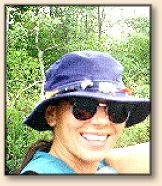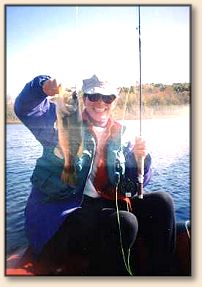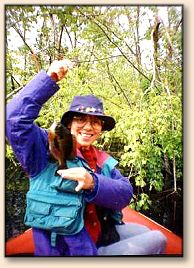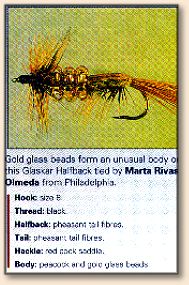|
Outdoors sports shows are excellent scenarios where one
can meet other anglers, buy fishing gadgets, books, rods
and other stuff that one doesn't necessarily need, but
feel compelled to have anyway. All these things would
end up piled somewhere, most probably, in the house. The
problem with piling this stuff somewhere in one's home - and
not finding it when it is needed - is, at times, one of the
reasons for buying more of it. Our apartment (which isn't
big at all) is filled with fishing equipment, brochures,
books, magazines and lots of fly-fishing videos. In addition,
there are also books from our respective professions, our son's
toys, and a bunch of souvenirs from all around the globe.
Needless to say, our living space has been shrunken quite a
bit, but I know that we aren't alone in this madness, as
piling stuff seems to be a very contagious illness among anglers
anyway, or anyone who has passion for her/his hobby. After
visiting a particular outdoor sports show in Philadelphia, we
returned home with the usual pile of brochures to peruse,
materials with which to tie our favorite flies, and a Renzetti
fly-tying vise. Little did I know then that this vise would
become my companion for quite a long time, as from that moment
on, I got hooked on fly-tying.
 Re-creating fly patterns from our fly-tying book's collection
and creating new ones became my new hobby. As a result, Jorge
would seldom get a turn at the vise, which gave him a good
reason to buy another one. On many occasions, Jorge and I
worked side-by-side, tying well-known patterns or designing
and tying new ones. Sometimes, each of us worked alone, but
alone or together, time seemed to fly when we were engaged in
the task of tying flies. And with a hectic schedule, finding
time to relax was not an easy chore. This is why fly-fishing
and fly-tying became effective ways for me to handle stress.
Both hobbies proved to be quite effective, particularly when
my parents, brother, and dissertation advisor passed away, all
within a short period of time (in 1992). For quite a while I
was breathing, eating and sleeping fly-fishing and fly-tying.
That's me wearing my hat with many of my own tied flies on the left.
This not only helped to decrease my stress level but also helped
me to focus on my work at the university, making my grieving
process more manageable. I felt so relaxed that stress was
seldom able to find its way into my mind no matter how hard
it tried. So it can be said that wanting to feel relaxed
caused me, in part, to get hooked on fly-tying. The other
reason for tying more of them was my bad habit of leaving
several flies tangled on tree branches.
Re-creating fly patterns from our fly-tying book's collection
and creating new ones became my new hobby. As a result, Jorge
would seldom get a turn at the vise, which gave him a good
reason to buy another one. On many occasions, Jorge and I
worked side-by-side, tying well-known patterns or designing
and tying new ones. Sometimes, each of us worked alone, but
alone or together, time seemed to fly when we were engaged in
the task of tying flies. And with a hectic schedule, finding
time to relax was not an easy chore. This is why fly-fishing
and fly-tying became effective ways for me to handle stress.
Both hobbies proved to be quite effective, particularly when
my parents, brother, and dissertation advisor passed away, all
within a short period of time (in 1992). For quite a while I
was breathing, eating and sleeping fly-fishing and fly-tying.
That's me wearing my hat with many of my own tied flies on the left.
This not only helped to decrease my stress level but also helped
me to focus on my work at the university, making my grieving
process more manageable. I felt so relaxed that stress was
seldom able to find its way into my mind no matter how hard
it tried. So it can be said that wanting to feel relaxed
caused me, in part, to get hooked on fly-tying. The other
reason for tying more of them was my bad habit of leaving
several flies tangled on tree branches.
 When we went fishing, Jorge would sometimes notice that I
wasn't casting and would say, "Marta, to catch a fish, your
line has to be in the water, and you have to cast close to
where the fish is rising, or where you think the fish is."
Following his advice I would try to cast wherever I saw a
rising fish or where my fishing instincts told me I should
cast. At times, I could see a fish rising from underneath
bushes or behind trees. His splash or sudden movements seemed
to be saying, "Hey, Marta, here I am, see if you can catch me."
Rising to the challenge, I would cast towards where the fish
was. If my fly presentations were good (and if the fish was
looking for food) it would take my fly. Next thing I'd know,
I'd be releasing a fish. Otherwise, my fly would be added to
the bobbers, lures and fishing lines that had become permanent
tree ornaments.
When we went fishing, Jorge would sometimes notice that I
wasn't casting and would say, "Marta, to catch a fish, your
line has to be in the water, and you have to cast close to
where the fish is rising, or where you think the fish is."
Following his advice I would try to cast wherever I saw a
rising fish or where my fishing instincts told me I should
cast. At times, I could see a fish rising from underneath
bushes or behind trees. His splash or sudden movements seemed
to be saying, "Hey, Marta, here I am, see if you can catch me."
Rising to the challenge, I would cast towards where the fish
was. If my fly presentations were good (and if the fish was
looking for food) it would take my fly. Next thing I'd know,
I'd be releasing a fish. Otherwise, my fly would be added to
the bobbers, lures and fishing lines that had become permanent
tree ornaments.

A smallie caught using my non-scientific method of fly selection!
On some trips, I was lucky enough (or perhaps I had become
more skillful, who knows?) to cast and fish throughout the
day using the same fly. Thus, I would be able to spend more
time fishing and less time tying on a new fly. This wasn't
always the case though. Sometimes, after having been nibbled
by hungry panfish, chain pickerels, or bass, the fly would
need to be put away for emergency repairs or to be discarded.
It would then be time to select and tie a new one. You must
know though, that my fly selection wasn't always based on what
I have read and learned from the experts. On occasions, I
would select a fly based on my taste for it and not because
it matched a natural.
 I would ask myself, "If I were a fish,
what kind of a fly would interest me the most?" After a short
but profound philosophical discussion with myself about which
fly to use, I would look into my fly box and select the one fly
I felt most attracted to, based on its color, material, size,
type and shape. My rationale? "Perhaps the fly selected would
be as attractive to the fish I was after, as it was to me."
Wanting to prove my hypothesis, I would begin to cast, and let
me tell you, this very simple non-scientific approach of
selecting a fly gave me good results on many fishing trips!
What can I say? Any technique that can help you catch a fish
should be given a chance!
I would ask myself, "If I were a fish,
what kind of a fly would interest me the most?" After a short
but profound philosophical discussion with myself about which
fly to use, I would look into my fly box and select the one fly
I felt most attracted to, based on its color, material, size,
type and shape. My rationale? "Perhaps the fly selected would
be as attractive to the fish I was after, as it was to me."
Wanting to prove my hypothesis, I would begin to cast, and let
me tell you, this very simple non-scientific approach of
selecting a fly gave me good results on many fishing trips!
What can I say? Any technique that can help you catch a fish
should be given a chance!
If a fly that I liked got tangled on a tree branch or underneath
the water surface (and if it was the last of its kind in my fly
box) I would want to get it back. I would ask Jorge to paddle
to the tree branch so I could pick up the tangled fly. But
picking it up wasn't always an easy task. First, Jorge wasn't
always willing to go pick it up, because for him, the time spent
getting the tangled fly could be used for fishing. "Forget
about that fly and just tie a new one," he would say, but at
my insistence, we would go to pick it up. Secondly, some of
the branches where my fly got tangled might be intertwined
with a poison ivy plant, and experience taught me that not
knowing what poison ivy looks like could make my life miserable
for almost two weeks! I know this from the one time that I,
unfortunately, unwittingly encountered it. As a result, I
developed an extremely allergic reaction to the poison ivy plant,
which caused me a visit to my primary care doctor. After this
incident I avoid getting close to this plant, for fear of suffering
its rage again.
Despite my experience with poison ivy, being able to get my
fly beyond, underneath, around or besides tree branches became
the target of my casting. I definitely wanted to hook and
release a fish, and no tree branch was going to get in my
way! Patiently, I kept on practicing my fly-casting, and
all this practice paid off. That is, most of the time my
fly landed exactly where I wanted it to, and not on a tree
branch. Other times...well, nobody is perfect!
As you can tell, I became truly hooked on fly-fishing and
fly-tying. My interest was such, that I began to create
my own designs and sent them out to fly-tying contests in
the U.S.A. I knew that hundreds of excellent fly-tiers
participated in these contests, but I couldn't help but
to feel disillusioned when my designs didn't even make
it to the runners' up category. Then again, as the saying
goes, no one is a prophet in her/his own land. But one
day, an article from the Still Water Trout Angler Magazine
from London caught my attention. Terry Griffiths, one of
the magazine-contributing editors, was encouraging readers
to send out their version of the Damsel Renegade's fly
pattern for the magazine contest. Jorge encouraged me
to enter the contest, and so I did.

My Damsel's Renegade design.
My Damsel's fly pattern design had twin clipped hackles
in yellow with white and fuchsia colors on a purple and
green chenille body. I sent it to London and to my surprise,
it appeared in the next Still Water Trout Magazine issue
of March 1994, as one of the versions Griffiths found
interesting enough to give it try! He particularly
liked the clipped hackle effect and the twin hackles
of my fly.
At the time, another hobby of mine was beading. That is,
I would make all kinds of jewelry (e.g. earrings, necklaces,
rings) with beads. After reading about how a particular
Norwegian woman crochets her flies, I asked myself, "Why
not use beads to tie some fly patterns and see what happens?"
The opportunity to create a beaded fly pattern presented itself
rather quickly. Once again, Terry Griffiths was asking readers
to send their version of an Alaskan Halfback pattern. I decided
to tie mine using gold glass beads for the body (sewn together),
pheasant tail fibers for the halfback and tail, and red cock
saddle for the hackle.
When I began to gather my materials, I found out I didn't
have any pheasant feathers. A trip downtown to the Orvis
store, where we were regular customers, was necessary
(Unfortunately, this Orvis store which was located in the
heart of Philadelphia on Walnut Street, to be exact, has
since moved to another location, outside the city limits).
 Mary, the store manager, and all the other employees were
very friendly and they were great fly anglers as well.
After the usual greeting and must-do fishing chat, I asked
Mary, "Do you have pheasant feathers at the store?"
"Unfortunately not," she said. As I explained to Mary my
reasons for wanting to buy pheasant feathers, one of the
other employees (I apologized for not being able to remember
his name, but my memory is not as good as it used to be!),
having overheard my conversation with Mary, went to the back
of the store and returned with a ladder. Next thing I knew,
the gentleman was climbing the ladder and plucking some
feathers from a mounted pheasant which was way up high on
the shelf. It had been there for quite a while, mainly for
the store's decoration purposes. Down the ladder he came
and said, "Here Marta, take these feathers with you and
tie a nice fly." His generosity touched my soul and thanking
him profusely, I said, "I am going to try my best."
Mary, the store manager, and all the other employees were
very friendly and they were great fly anglers as well.
After the usual greeting and must-do fishing chat, I asked
Mary, "Do you have pheasant feathers at the store?"
"Unfortunately not," she said. As I explained to Mary my
reasons for wanting to buy pheasant feathers, one of the
other employees (I apologized for not being able to remember
his name, but my memory is not as good as it used to be!),
having overheard my conversation with Mary, went to the back
of the store and returned with a ladder. Next thing I knew,
the gentleman was climbing the ladder and plucking some
feathers from a mounted pheasant which was way up high on
the shelf. It had been there for quite a while, mainly for
the store's decoration purposes. Down the ladder he came
and said, "Here Marta, take these feathers with you and
tie a nice fly." His generosity touched my soul and thanking
him profusely, I said, "I am going to try my best."
I left the store carrying with me not only the necessary
materials to tie my fly, but good luck wishes from everyone.
Once at home, I began to tie my beaded version of the Alaskan
halfback. When finished, I sent it to Terry Griffiths in
London. He named it the Glasskar Halfback and included it
in the June of 1994 issue of the magazine as an honorable
mention. I am very thankful to Terry Griffiths for
recognizing the fishing potential of both, my Damsel Renegade
and Glasskar Halfback flies. ~ Marta
|

 Re-creating fly patterns from our fly-tying book's collection
and creating new ones became my new hobby. As a result, Jorge
would seldom get a turn at the vise, which gave him a good
reason to buy another one. On many occasions, Jorge and I
worked side-by-side, tying well-known patterns or designing
and tying new ones. Sometimes, each of us worked alone, but
alone or together, time seemed to fly when we were engaged in
the task of tying flies. And with a hectic schedule, finding
time to relax was not an easy chore. This is why fly-fishing
and fly-tying became effective ways for me to handle stress.
Both hobbies proved to be quite effective, particularly when
my parents, brother, and dissertation advisor passed away, all
within a short period of time (in 1992). For quite a while I
was breathing, eating and sleeping fly-fishing and fly-tying.
That's me wearing my hat with many of my own tied flies on the left.
This not only helped to decrease my stress level but also helped
me to focus on my work at the university, making my grieving
process more manageable. I felt so relaxed that stress was
seldom able to find its way into my mind no matter how hard
it tried. So it can be said that wanting to feel relaxed
caused me, in part, to get hooked on fly-tying. The other
reason for tying more of them was my bad habit of leaving
several flies tangled on tree branches.
Re-creating fly patterns from our fly-tying book's collection
and creating new ones became my new hobby. As a result, Jorge
would seldom get a turn at the vise, which gave him a good
reason to buy another one. On many occasions, Jorge and I
worked side-by-side, tying well-known patterns or designing
and tying new ones. Sometimes, each of us worked alone, but
alone or together, time seemed to fly when we were engaged in
the task of tying flies. And with a hectic schedule, finding
time to relax was not an easy chore. This is why fly-fishing
and fly-tying became effective ways for me to handle stress.
Both hobbies proved to be quite effective, particularly when
my parents, brother, and dissertation advisor passed away, all
within a short period of time (in 1992). For quite a while I
was breathing, eating and sleeping fly-fishing and fly-tying.
That's me wearing my hat with many of my own tied flies on the left.
This not only helped to decrease my stress level but also helped
me to focus on my work at the university, making my grieving
process more manageable. I felt so relaxed that stress was
seldom able to find its way into my mind no matter how hard
it tried. So it can be said that wanting to feel relaxed
caused me, in part, to get hooked on fly-tying. The other
reason for tying more of them was my bad habit of leaving
several flies tangled on tree branches.

 I would ask myself, "If I were a fish,
what kind of a fly would interest me the most?" After a short
but profound philosophical discussion with myself about which
fly to use, I would look into my fly box and select the one fly
I felt most attracted to, based on its color, material, size,
type and shape. My rationale? "Perhaps the fly selected would
be as attractive to the fish I was after, as it was to me."
Wanting to prove my hypothesis, I would begin to cast, and let
me tell you, this very simple non-scientific approach of
selecting a fly gave me good results on many fishing trips!
What can I say? Any technique that can help you catch a fish
should be given a chance!
I would ask myself, "If I were a fish,
what kind of a fly would interest me the most?" After a short
but profound philosophical discussion with myself about which
fly to use, I would look into my fly box and select the one fly
I felt most attracted to, based on its color, material, size,
type and shape. My rationale? "Perhaps the fly selected would
be as attractive to the fish I was after, as it was to me."
Wanting to prove my hypothesis, I would begin to cast, and let
me tell you, this very simple non-scientific approach of
selecting a fly gave me good results on many fishing trips!
What can I say? Any technique that can help you catch a fish
should be given a chance! 
 Mary, the store manager, and all the other employees were
very friendly and they were great fly anglers as well.
After the usual greeting and must-do fishing chat, I asked
Mary, "Do you have pheasant feathers at the store?"
"Unfortunately not," she said. As I explained to Mary my
reasons for wanting to buy pheasant feathers, one of the
other employees (I apologized for not being able to remember
his name, but my memory is not as good as it used to be!),
having overheard my conversation with Mary, went to the back
of the store and returned with a ladder. Next thing I knew,
the gentleman was climbing the ladder and plucking some
feathers from a mounted pheasant which was way up high on
the shelf. It had been there for quite a while, mainly for
the store's decoration purposes. Down the ladder he came
and said, "Here Marta, take these feathers with you and
tie a nice fly." His generosity touched my soul and thanking
him profusely, I said, "I am going to try my best."
Mary, the store manager, and all the other employees were
very friendly and they were great fly anglers as well.
After the usual greeting and must-do fishing chat, I asked
Mary, "Do you have pheasant feathers at the store?"
"Unfortunately not," she said. As I explained to Mary my
reasons for wanting to buy pheasant feathers, one of the
other employees (I apologized for not being able to remember
his name, but my memory is not as good as it used to be!),
having overheard my conversation with Mary, went to the back
of the store and returned with a ladder. Next thing I knew,
the gentleman was climbing the ladder and plucking some
feathers from a mounted pheasant which was way up high on
the shelf. It had been there for quite a while, mainly for
the store's decoration purposes. Down the ladder he came
and said, "Here Marta, take these feathers with you and
tie a nice fly." His generosity touched my soul and thanking
him profusely, I said, "I am going to try my best."